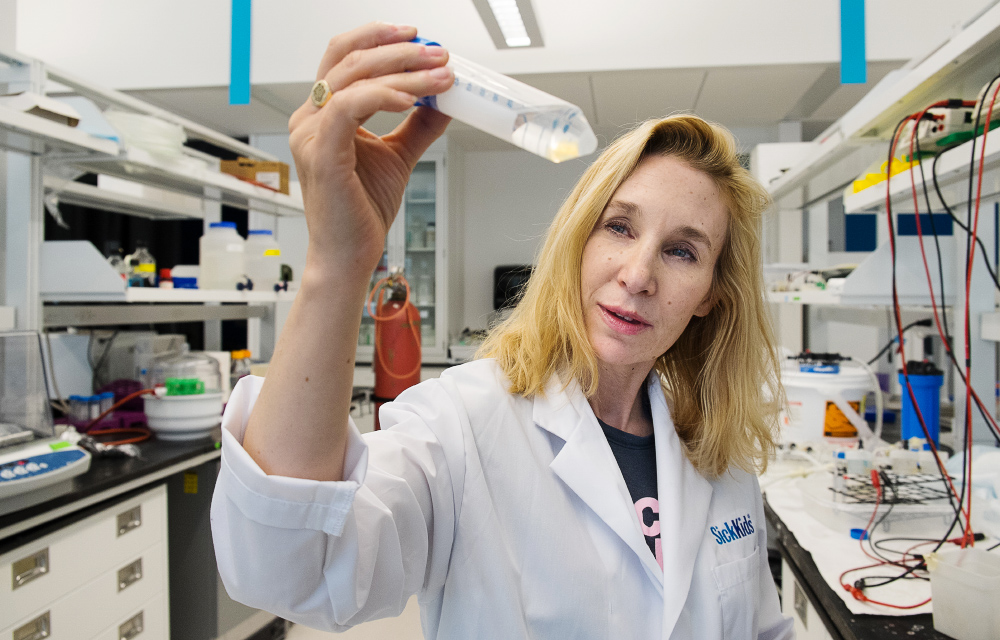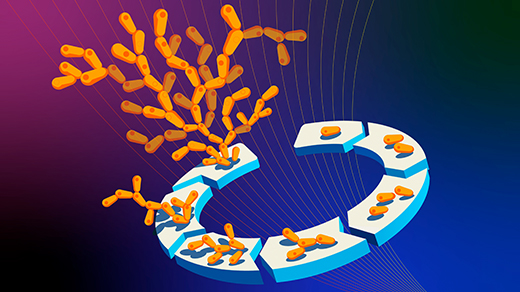The Maestro of Memory Manipulation
A failed 30-year-long quest launched Sheena Josselyn on her current career path. As a psychology major in college, Josselyn, now a neuroscientist at the University of Toronto, had studied the work of Karl Lashley, a famous psychologist who theorized that memories are stored in a collection of brain cells that fire in a certain pattern, known as an engram. The basic idea is that the brain stores a memory — the Seinfeld theme song or the scent of your mother’s perfume — by strengthening the connections among a specific set of neurons. When the brain recalls that memory, the cells fire in the same pattern.
Lashley hoped to prove the engram’s existence by demonstrating that selectively destroying bits of brain tissue would eradicate specific memories. But despite decades spent carefully poking around in the rodent brain, Lashley never managed to localize memory. In 1950, he admitted defeat, proposing instead that memories were not contained within a small set of cells but distributed across the brain.
Josselyn thought of Lashley’s lengthy quest when she was a postdoc at Yale in the 1990s, puzzling over the result of an experiment in mice. She had tinkered with some cells in a part of the brain known as the amygdala, which is tied to emotional memory. Though she had only altered a few cells, the treatment dramatically improved the animals’ memory. These mice were much better at remembering a scary incident — a tone paired with a shock — than their untreated counterparts.
Josselyn began to suspect that she had stumbled upon Lashley’s engram, but it took her nearly ten years to come up with real proof. In 2009, her team demonstrated that they could erase a specific memory in mice by killing a certain set of cells. More than a century after Lashley began his search for the engram, Josselyn finally found it.
The key to her team’s success was a set of molecular tools designed to mark the brain cells that formed a new memory — the neurons that fired when the mice learned that a specific sound predicted an imminent electric shock. The researchers then used these molecular tags to wipe out only those brain cells, eradicating that memory but leaving others intact.
Since then, researchers have used these and other tools to toy with the engram in ever more sophisticated ways. They can silence or activate the cells that make up the memory’s pattern, erasing and evoking specific memories and even implanting false memories.
The power to control memory is both exciting and frightening. It evokes the dark images of science fiction movies such as Eternal Sunshine of the Spotless Mind, in which a couple erases painful memories of each other. But the research also has the potential to unlock the mystery of memory disorders such as post-traumatic stress disorder (PTSD), perhaps leading to new treatments.
Josselyn is now trying to unpack the engram’s molecular nuts and bolts, which she hopes will spark development of new therapies for addiction, Alzheimer’s disease and other illnesses. Quanta Magazine recently spoke with Josselyn about her search for the engram. An edited and condensed version of that conversation follows.
QUANTA MAGAZINE: What is an engram?
SHEENA JOSSELYN: It’s the physical manifestation of a memory in the brain, a collection of cells that, if we activate them, express a memory. It changes when we learn something and fires again when we recall something.
How does the brain create an engram?
We believe that the synaptic connections between neurons chosen to be part of an engram get stronger, thereby creating a mini-network.
You were drawn to the field by Lashley’s 30-year quest to find the engram. How did Lashley try to prove its existence?
He did ingenious experiments where he trained a rat to run a maze and then systematically destroyed different bits of the brain, trying to figure out exactly where this memory was stored. The idea was that if he found it, the animal would have no memory of how to traverse the maze. He concentrated on the cortex, the bit of the brain closest to the skull.
At the end of his 30-year quest, he came up empty-handed. He couldn’t find exactly where in the brain this memory was stored. It was sort of everywhere — if he destroyed a large part of the brain, it would affect memory. But a small lesion, no matter where, would do nothing. He thought the engram was everywhere but nowhere specific. It was a cautionary tale. People stopped looking for a specific place where memory was stored.
More than 60 years later, the study of the engram has taken off. Why?
The real turnaround came when we had more selective tools that could silence or activate specific cells.
Why are these tools so important?
There are a million cells in the brain, but only a small number of them form the engram for any particular memory. We think the cells that are active during the learning event comprise the critical component of an engram. Modern-day techniques allow us to visualize and manipulate those cells, to tag and then activate or deactivate them later. Now we can redo Lashley’s experiments, but instead of killing wide swaths of the cortex, we can target just the cells that were active during a learning event. We found that silencing those cells suppresses the memory, and activating them brings the memory back. That’s a proof of principle that the engram exists, and that we can specifically manipulate it.
How do you know what the mice are thinking when you activate the engram? How do you know that they are remembering the event?
We’re not sure if it’s an actual memory. But if you just activate these cells, the animal looks fearful — it freezes. It’s as if we’re bypassing the ears and going straight to the brain. We are making the animal afraid without actually having to play the sound.
Does this only work with fearful memories? Can you alter other types of memories as well?
Yes, we’ve manipulated a cocaine-based memory. We teach an animal to associate a particular place with cocaine, and the animal spends most of its time in that area. Then we erase that memory by killing the cells that are part of the engram. It’s like the animal has never had cocaine in that environment — it no longer prefers that area.
Sometimes people who have had problems with drug abuse do fine in rehab, where they are removed from a lot of the cues associated with drug taking. But when they get back in the environment where they previously took drugs, they can relapse, because they expect and crave the drugs that have become associated with these places. We tried to get at the heart of that by saying: Can we do something to weaken this cocaine memory? By just manipulating cells that we think are important, we got the animal to act is if it never had cocaine before.
Does that mean you can reverse cocaine addiction in mice?
The animal is not quite addicted; we don’t give it a lot of experience with cocaine. But this could be the first step in treating addiction.
Can this approach be translated to humans?
Right now, the wonderful world of technology we are using in mice cannot easily be applied to people. But we can take the principles we learned from these studies and try to think of new ways of treating people. The results provide proof of principle that maybe we don’t need to target every cell in the body when we do these treatments. Maybe we can develop drugs that target just active cells.
So you can spark memories and erase them — what other strange things can scientists do to memory?
People have all kinds of ways of playing with this, now that we can guide or tag an engram. For example, scientists have implanted false memories. They reactivate a spatial engram — a pattern of activity associated with a specific place — and pair that with a shock. Then the mice freeze in a place they haven’t been shocked before.
What do you want to do next?
Right now, we look at very artificial experiences. We teach mice one thing and test one thing, pairing a shock and a tone, for example. But we want to look at more everyday experiences, how these things layer on top of one another. Mice and humans are capable of learning many different things. How does an engram go on to become knowledge rather than a specific memory? Can we make engrams last forever? What happens when we get older, and our memories get mixed up? Do engrams get mixed up? How do rewarding memories interact with negative memories? How does this change at different ages?
One really important component that we’re missing is timing. These cells probably fire in a unique way to bring about a memory, similar to Morse code. Right now we have a blunt approach for activating cells: blanket-firing the cells all together. That works for simple memories — like pairing a tone and a shock — but it’s probably not how the finely tuned orchestra of cells in the brain work. We have to drill down and get more sophisticated ways of reading the brain.
Aren’t you concerned about the ethical implications of this work?
I think that the ethical considerations are enormous, especially if this technology is translated to humans. Is it ethical to simply “erase” a bad memory that someone finds distasteful to remember? We all learn from past mistakes, so it is important that these memories be left intact. For instance, remembering that as a kid I touched a hot stove prevents me from touching it again. The memory is of a painful event, but if I had it “erased,” I would repeat the same mistake. It gets much trickier when someone may have a devastating memory that interferes with normal life. For instance, in the case of PTSD, it might improve health and well-being to somehow erase or manipulate a memory that interferes with normal functioning. Where to draw the line is going to become very tricky.
Does this research vindicate Lashley? Was his original theory of memory ultimately proved right?
Yes and no. The engram is more complex than we originally thought. It is not just a spot in the brain that houses a memory. Current techniques have allowed us to find components of the engram, but we haven’t yet found the entire engram — we believe this is widely distributed throughout the brain and may change as a memory ages. Most people look at a bunch of neurons in one specific brain region. I’m as guilty of this as anyone. But it’s getting to be old-fashioned now to look at one region at a time. We need to look across these areas because the brain is probably communicating across large regions and working together as one.
When you first started thinking about the engram in 1999, did you have any inkling of where you would be today?
When we started, we never thought we could do the crazy experiments that are possible today. We thought we would be out on a limb and no one would take us seriously. But as time goes by, more and more people are becoming interested. It’s now 2016, so I have been working on this problem for 17 years. Not quite as long as Lashley, but I am quickly approaching that!




